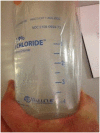Practically Saline
- PMID: 26668812
- PMCID: PMC4674994
- DOI: 10.1177/2324709615618980
Practically Saline
Abstract
Introduction. In December 2014, the Food and Drug Administration issued a recall of all Wallcur simulation products due to reports of their use in clinical practice. We present a case of septic shock and multiorgan failure after the accidental intravenous infusion of a nonsterile Wallcur simulation product. Case. The patient presented with symptoms of rigors and dyspnea occurring immediately after infusion of Wallcur Practi-0.9% saline. Initial laboratory evidence was consistent with severe septic shock and multiorgan dysfunction. His initial lactic acid level was 9 mmol/L (reference range = 0.5-2.2), and he had evidence of acute kidney injury and markers of disseminated intravascular coagulation. All 4 blood culture bottles isolated multidrug-resistant Empedobacter brevis. The patient recovered from his illness and was discharged with ciprofloxacin therapy per susceptibilities. Discussion. This patient represents the first described case of severe septic shock associated with the infusion of a Wallcur simulation product. Intravenous inoculation of a nonsterile fluid is rare and exposes the patient to unusual environmental organisms, toxins, or unsafe fluid characteristics such as tonicity. During course of treatment, we identified the possible culprit to be a multidrug-resistant isolate of Empedobacter brevis. We also discuss the systemic failures that led to this outbreak.
Keywords: Empedobacter brevis; contaminated saline; nonsterile intravenous fluid; septic shock.
Conflict of interest statement
Figures
References
LinkOut - more resources
Full Text Sources
Other Literature Sources


